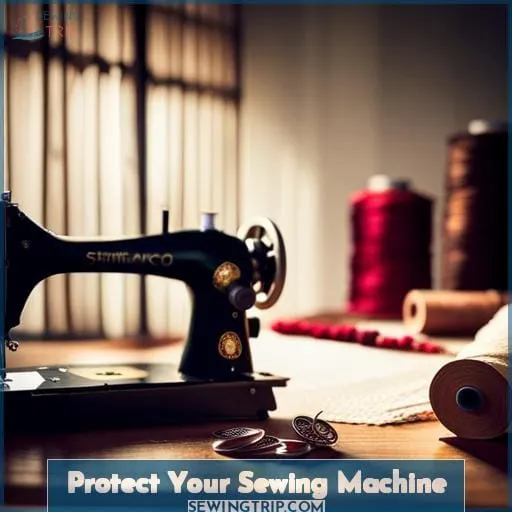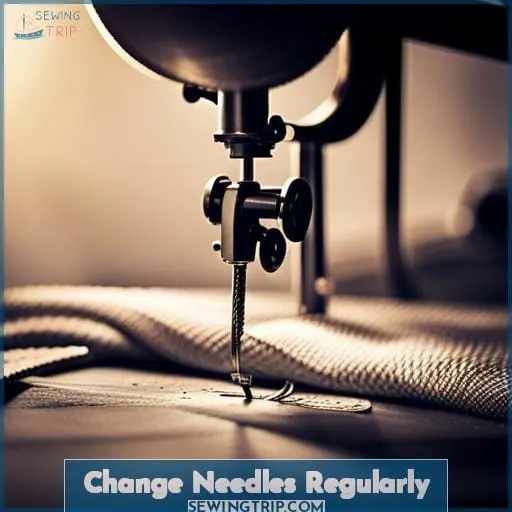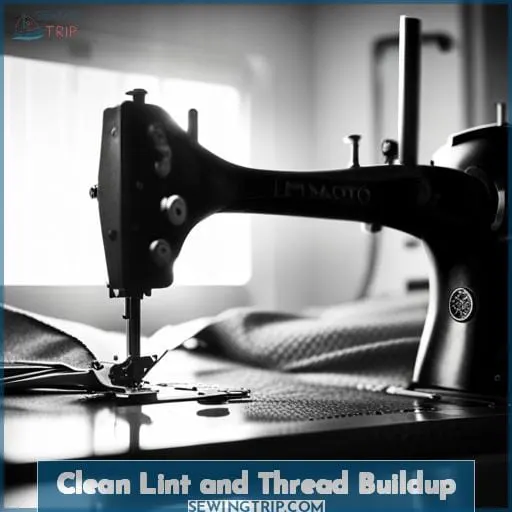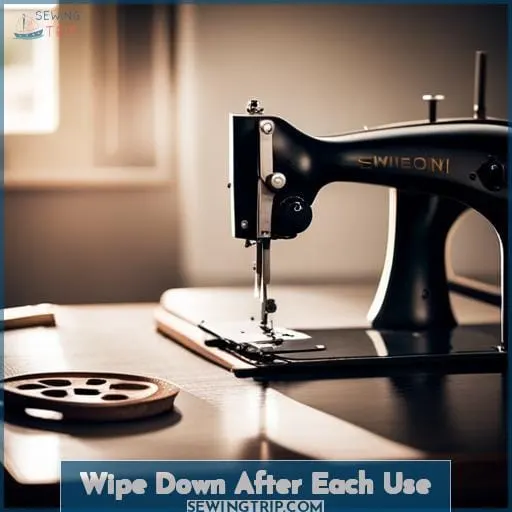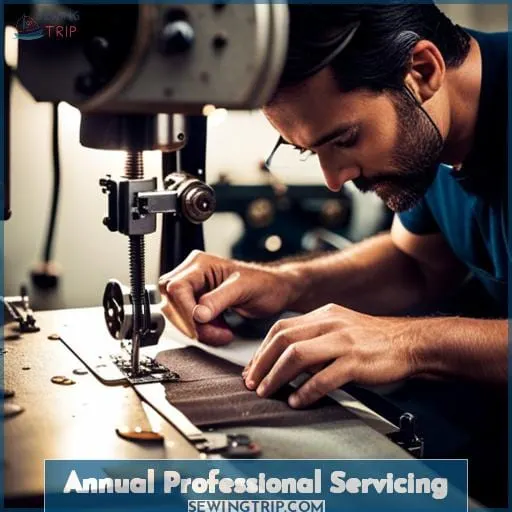This site is supported by our readers. We may earn a commission, at no cost to you, if you purchase through links.
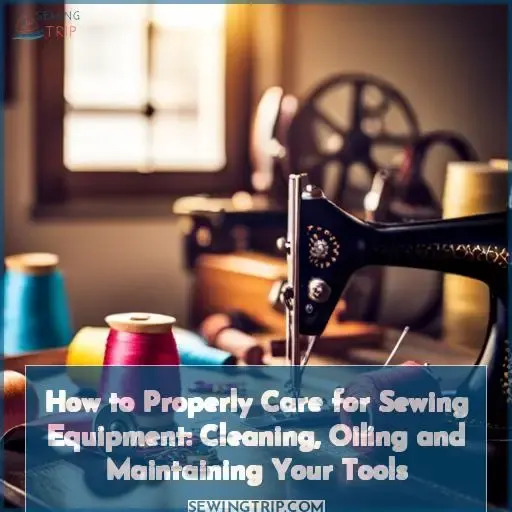 Your sewing tools deserve some TLC to keep them in top shape.
Your sewing tools deserve some TLC to keep them in top shape.
Give your machine some regular cleanings to remove lint and dust buildup.
Oil the internal parts now and then to keep things running smoothly.
Remember to change your needle frequently, and wipe down tools after each use.
With proper care, your sewing equipment will last years, so take a few minutes to show your tools some love.
Table Of Contents
Key Takeaways
- Change needles regularly to keep stitches smooth and prevent damage
- Use compressed air to safely remove lint and threads from crevices
- Apply sewing machine oil every few weeks to lubricate parts and prevent overheating
- Wipe down surfaces after each use to prevent buildup and keep mechanisms clean
Protect Your Sewing Machine
When it comes to caring for your sewing machine, protection is key.
Use a cover or case when the machine isn’t in use to prevent dust buildup and accidental damage.
Also, remember to unplug the machine when you’re done sewing for the day or plan to be away for an extended period.
Use a Cover
By putting a cover on your sewing machine when not in use, you’ll protect its delicate mechanisms from dust, dirt, and potential damage.
Stylish protectors, DIY machine cozies, seasonal wraps, or decorative safeguards shield your equipment and show off your creativity.
Customize covers to suit your space and mood.
Keeping machines clean and maintained ensures quality stitching for years to come.
Unplug When Not in Use
You should also unplug your sewing machine when it’s not in use for extended periods.
- Unplug from wall outlet when not using for over a week. This saves energy and protects from power fluctuations.
- Avoid leaving plugged in near water sources. Electrical accidents can occur.
- Store cord neatly coiled to prevent tripping or wire damage.
Change Needles Regularly
You’ll save yourself headaches if you change needles regularly.
Dull needles make stitches look bad and damage fabric.
Replace needles after around 8 hours of sewing or finishing a project.
Match needles to fabric weight so stitches are smooth, not skipped or looping.
Check needles often for burrs, straightness, and sharp tips.
Damaged needles snag threads and fabrics.
Keeping fresh, quality needles makes sewing efficient and extends machine life by preventing skipped timing.
Use the right needles and you’ll smile at perfectly formed stitches on any fabric.
Clean Lint and Thread Buildup
After regularly changing your needles, you’ll want to clean any lint and thread buildup.
Use compressed air to blow away lint and threads from the feed dogs, bobbin area, and tension discs.
Hold the air nozzle at least 4 inches away and use short bursts of air to prevent moisture buildup inside your machine.
Focus the airflow only on areas that accumulate lint.
Take your time and be precise; rushing can push debris further into crevices.
Proper airflow techniques prevent skipped stitches from lint-clogged feed dogs.
Keep lint cleaned out for smooth sewing and to prevent premature needle dulling.
Maintaining a lint-free machine ensures your equipment continues stitching smoothly for years to come.
Oil Internal Parts
Additionally, you should apply some sewing machine oil to internal components about once a month to lubricate moving parts and help prevent wear.
- Apply just a few drops of high-quality sewing machine oil to key internal parts like the hook race, shuttle, bobbin case, feed dogs, and other moving metal components.
- Refer to your machine’s manual for oiling guides specific to your make and model.
Oiling every 3-4 weeks helps lubricate internal mechanisms, prevent overheating, and extends your machine’s lifespan.
Wipe Down After Each Use
Maintenance calls for wiping your machine down after each use to remove dust, lint, oil residue, and stray threads that could otherwise build up and cause damage over time.
Make post-project cleanup part of your daily equipment care ritual.
Wipe the machine’s surfaces thoroughly with a soft lint-free cloth to remove any debris.
Pay special attention to the needle area, feed dogs, bobbin case, tension discs, and crevices.
Tidy stray threads and bits of fabric.
A quick usage aftercare regime keeps your sewing equipment in good working order for countless creative projects ahead.
Establishing surface hygiene and maintenance rituals now prevents headaches later.
Annual Professional Servicing
You should take your sewing machine into a professional repair shop annually for a complete tuneup.
A skilled technician will:
- Adjust the timing and tension for optimal stitch formation
- Lubricate all moving parts
- Clean inaccessible areas to keep your machine running smoothly
This service will:
- Maintain precision stitching
- Extend the working life of your sewing equipment
Timing Adjustment
One key step in your machine’s annual servicing is having its timing adjusted by a professional.
Proper timing alignment ensures precision stitch formation, so projects turn out perfectly.
Misaligned timing causes skipped or uneven stitches, so this adjustment keeps your machine stitching smoothly for years to come.
Annual professional servicing maximizes longevity by catching issues early.
Tension Adjustment
You’ll also want the technician to adjust the tension of both the upper and bobbin threads.
This ensures precise stitch formation and prevents puckering, bunching, or looping.
Finding the perfect balance through tension tips and troubleshooting will lead to tension mastery – the key to perfect stitching when caring for your sewing equipment.
Frequently Asked Questions (FAQs)
How often should I replace my machine’s lightbulb?
Unfortunately, there’s no definitive recommendation on how often to replace a sewing machine’s lightbulb.
It depends on factors like usage and the type of bulb.
Check the bulb periodically and replace it if it seems dim or burnt out.
LED bulbs last significantly longer than traditional incandescent bulbs.
My machine is making a strange clicking sound. What should I check?
Check the motor’s drive belt. It could have come loose or developed a worn spot, causing it to slip.
Inspect the bobbin case, feed dogs, and needle bar. Lubricate these moving parts if needed.
Remove lint and threads around the needle and tension discs.
How do I safely store my sewing machine if I need to move it or won’t be using it for an extended period?
Like a hibernating bear, gently tuck your sewing machine into a snug, breathable case to keep it safe and undisturbed.
Choose a dry, room-temperature spot away from direct sun to prevent cracks, rust, or dust buildup over time.
Handle with care.
What type of bobbins does my machine use and where can I purchase extras?
Check your machine’s manual to identify the exact bobbin model needed.
Quality bobbins compatible with your machine type are available at craft and fabric stores or from the machine’s manufacturer.
The tension seems off but I’ve cleaned everything I can access. What should my next troubleshooting steps be?
Have a sewing technician check the machine’s timing and tension.
They can properly adjust parts you can’t access yourself to resolve tension problems.
Going to a professional ensures proper troubleshooting and calibration.
Conclusion
Ultimately, caring for your sewing equipment extends its lifespan.
Much like oiling a bike chain, regular cleanings prevent jamming, while replacing dull needles saves frustration.
We all cherish reliable tools; so before your next project, show yours affection.
Maintaining your trusty machine ensures many more special creations to come – preserving not just heirlooms, but traditions connecting generations.

